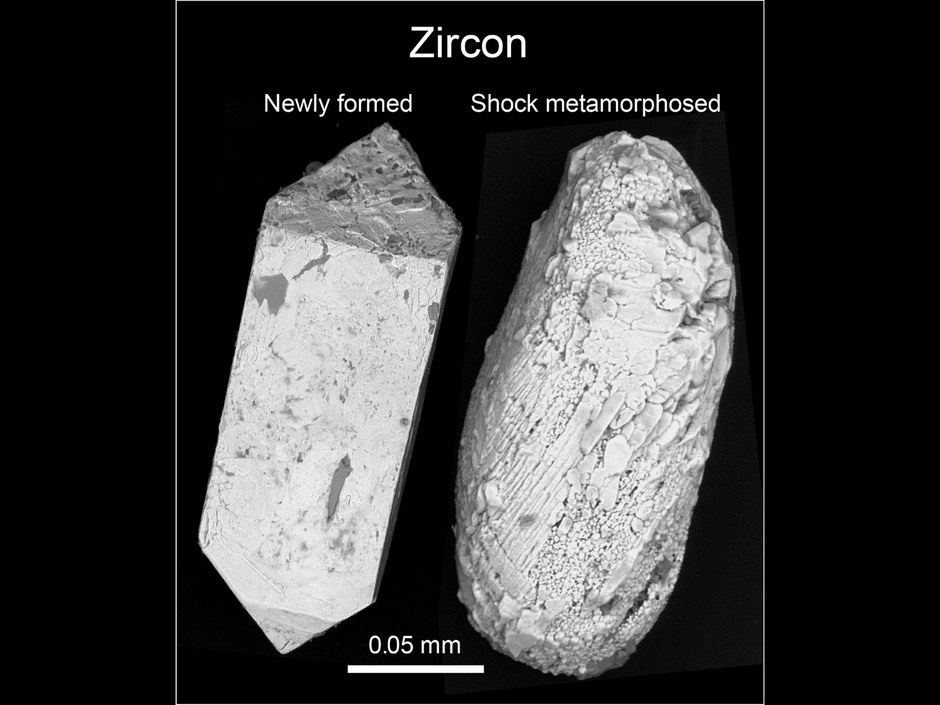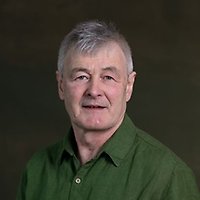Forskningsområden: Geovetenskap
Forskningsämnen: Geokronologi, Geologiska och förhistoriska händelser, Rymdforskning
Project overview
Project period: 2018 –Ongoing
Participating departments from the museum: Department of Geosciences, GEO
The formation of impact craters – when a planet or moon is struck by an asteroid or comet – is a fundamental geological process visible throughout the Solar System. Geologists have identified approximately 200 impact structures on Earth but only a quarter of these have been accurately and precisely dated. Therefore, we are, quite simply, unsure when most of these impact structures formed.

Scanning electron microscope (SEM) images of two types of zircon crystals used in the dating of impact structures on Earth. Image: Gavin Kenny
Project description
Determining the age of impact craters is not an easy task. In this project, we are developing and improving methods for dating shocked minerals, i.e. those that have been exposed to the extreme pressures and temperatures of impact events.
In the picture above, you can see two types of zircon crystals that are used to determine the age of impact structures. The zircon on the left crystallized from a 2–3 km deep pool of impact melt at the Sudbury impact structure, Ontario, Canada. Newly crystallized zircons are quite easy to work with, but they only form in the largest impacts and have, therefore, only been found in a few impact structures.
The zircon on the right is from an impact melt-bearing breccia from above the Sudbury melt sheet, and similar crystals are found in most craters. This zircon originally crystallized in a granite long before the impact but recrystallized due to the extreme pressures and temperatures it was exposed to. Consequently, it now also records the time of the impact. It is not easy to work with such complex crystals, but at the Swedish Museum of Natural History we have developed specific routines for analysing and dating this type of crystal.
We use instruments and equipment found at the museum: equipment for crushing and mineral separation, a scanning electron microscope (SEM) for imaging and microstructural analysis, and a CAMECA IMS1280 ion microprobe for uranium-lead dating.
We have dated impact craters around the world, from Sweden to Greenland and South Africa, and continue to work on well-known and newly discovered craters.
Funding
- European Union’s Horizon 2020 research and innovation programme: Marie Skłodowska-Curie Individual Fellowship Grant Agreement No. 792030
- Royal Swedish Academy of Sciences Grant No. GS2021-0016
Selected publications
Kenny, G. G., Hyde, W. R., Storey, M., Garde, A. A., Whitehouse, M. J., Beck, P., Johansson, L., Søndergaard, A. S., Bjørk, A. A., MacGregor, J. A., Khan, S. A., Mouginot, J., Johnson, B. C., Silber, E. A., Wielandt, D. K. P., Kjær, K. H., Larsen, N. K., 2022. A Late Paleocene age for Greenland’s Hiawatha impact structure. Science Advances 8, eabm2434. https://doi.org/10.1126/sciadv.abm2434 External link.
External link.
Kenny, G. G., Harrigan, C. O., Schmitz, M. D., Crowley, J. L., Wall, C. J., Andreoli, M. A. G., Gibson, R. L., Maier, W. D., 2021. Timescales of impact melt sheet crystallization and the precise age of the Morokweng impact structure, South Africa. Earth and Planetary Science Letters 567, 117013. https://doi.org/10.1016/j.epsl.2021.117013 External link.
External link.
Kenny, G.G., Mänttäri, I., Schmieder, M., Whitehouse, M.J., Nemchin, A.A., Bellucci, J.J., Merle, R.E., 2020. Age of the Sääksjärvi impact structure, Finland: reconciling the timing of small impacts in crystalline basement with regional basin development. Journal of the Geological Society of London 177, 1231–1243. https://doi.org/10.1144/jgs2020-034 External link.
External link.
Kenny, G. G., Schmieder, M., Whitehouse, M. J., Nemchin, A. A., Morales, L. F. G., Buchner, E., Bellucci, J. J., Snape, J. F., 2019. A new U-Pb age for shock-recrystallised zircon from the Lappajärvi impact crater, Finland, and implications for the accurate dating of impact events. Geochimica et Cosmochimica Acta 245, 479–494. https://doi.org/10.1016/j.gca.2018.11.021 External link.
External link.
Project members
External participants
- Lund University, Sweden, https://www.lunduniversity.lu.se/
 External link.
External link. - University of Copenhagen, Denmark, https://www.ku.dk/
 External link.
External link. - Curtin University, Perth, Australia, https://www.curtin.edu.au/
 External link.
External link. - Boise State University, Idaho, USA, https://www.boisestate.edu/
 External link.
External link.
Project manager
Project member


